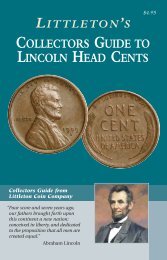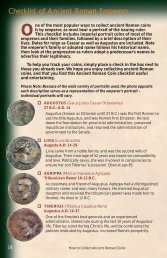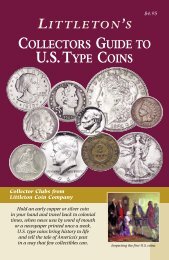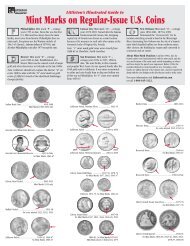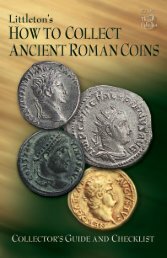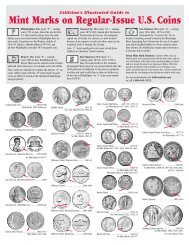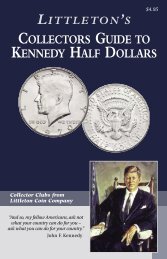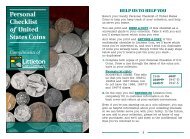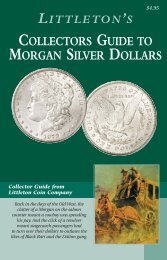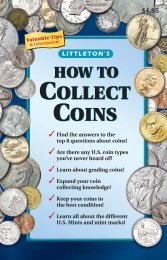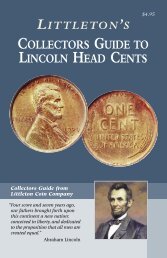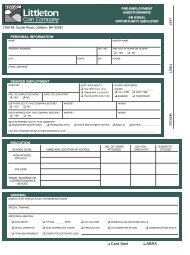Collecting Paper Money - Littleton Coin Company
Collecting Paper Money - Littleton Coin Company
Collecting Paper Money - Littleton Coin Company
Create successful ePaper yourself
Turn your PDF publications into a flip-book with our unique Google optimized e-Paper software.
paper money glossary<br />
{<br />
36|<br />
The star at the<br />
beginning of the<br />
serial number on a<br />
Star Note<br />
Treasury Seal shown<br />
here in green<br />
behind the 500<br />
A vignette from the<br />
“Woodchopper” Note<br />
Reference Books<br />
www.littletoncoin.com<br />
Silver Certificate Authorized by the U.S. government in<br />
1878, it is the second longest-lived paper money series.<br />
Once redeemable for silver coins or bullion, it is still<br />
considered legal tender at face value, but is no longer<br />
redeemable for silver.<br />
Small-Size Refers to modern U.S. paper currency that<br />
measures 61 ⁄8˝ x 25 ⁄8˝, first issued in 1929 (see pages 14-18).<br />
Star Note Also known as Replacement Note. A Star Note is<br />
issued when the Bureau of Engraving and Printing discovers<br />
a note that has been damaged during manufacture. These<br />
notes replace the damaged ones and usually bear a star<br />
either before or after the serial number.<br />
Syngraphics A word coined in 1974 to denote the study<br />
and collecting of paper money; based on the Latin word<br />
syngrapha, meaning a written promise to pay.<br />
Treasury Note Also known as a <strong>Coin</strong> Note. First issued in<br />
1890, Treasury Notes were redeemable for gold and silver<br />
coins.<br />
16 Treasury Seal An emblem of the United States<br />
Treasury, a symbol that the currency is legally produced;<br />
printed on all notes, except for some Fractional Currency<br />
and the Demand Notes of 1861.<br />
Vignette The picture on a note that gradually fades into<br />
the surrounding background rather than being enclosed<br />
within a frame or outlines.<br />
Watermark An embedded design created at the time<br />
of manufacture by varying the density and thickness of<br />
the paper. The watermark can be seen when held up to<br />
light. Because it is part of the paper and cannot be<br />
reproduced by copiers or scanners, it is an effective<br />
anti-counterfeiting measure.<br />
<strong>Paper</strong> <strong>Money</strong> of the United States by Arthur and Ira Friedberg A catalog<br />
of U.S. paper money from 1861 to the present. Faces and backs of all classes<br />
and types of currency shown – from 3¢ to $10,000. More than 800 photographs,<br />
accompanied by text which lists and describes every U.S. paper money<br />
type issued.<br />
U.S. <strong>Paper</strong> <strong>Money</strong> Guide and Handbook by Carlson R. Chambliss In-depth<br />
history of U.S. federal paper money, with several chapters on non-federal issues.<br />
Includes information on care and preservation, a bibliography, and much more.<br />
Comprehensive Catalog of U.S. <strong>Paper</strong> <strong>Money</strong> by Gene Hessler Important<br />
reference loaded with information, pictures, and the history of U.S. paper money.<br />
Organized by denomination from $1 to $100,000 notes.<br />
{littleton coin company



